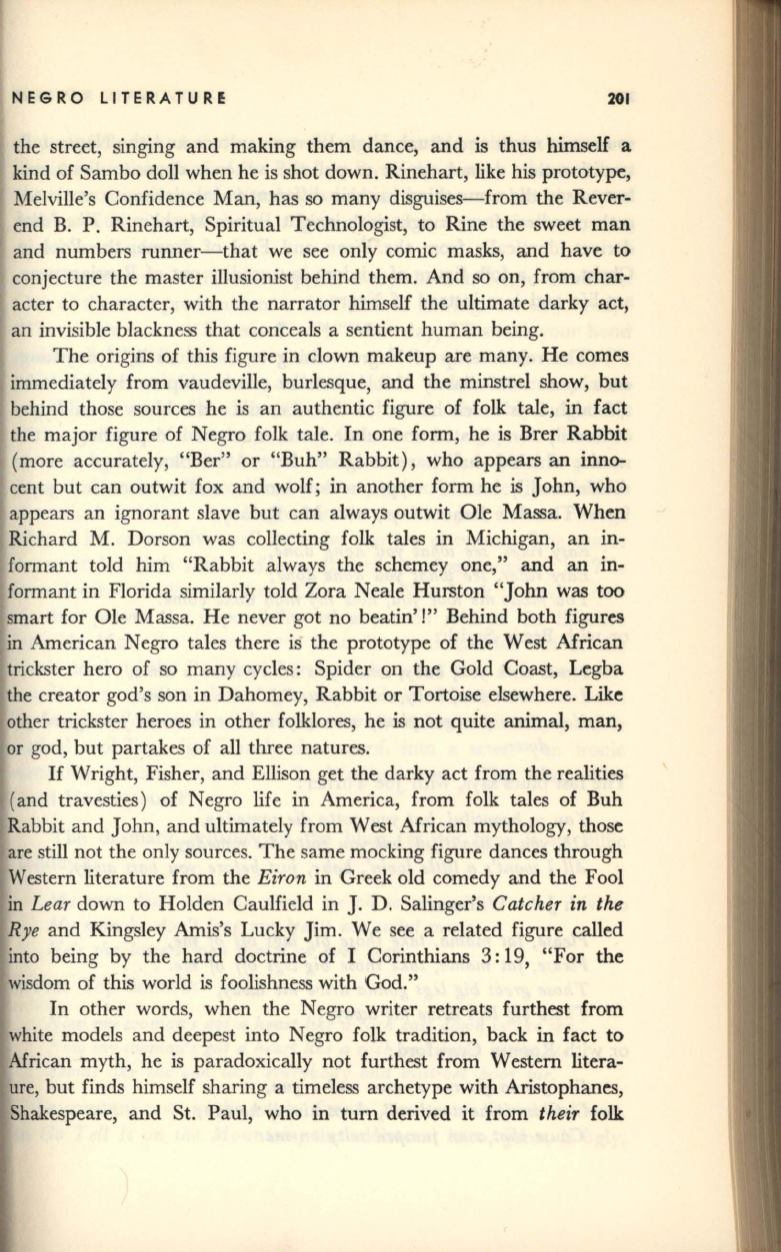
NEGRO LITERATURri
201
the street, singing and making them dance, and is thus himself a
kind of Sambo doll when he is shot down. Rinehart, like his prototype,
Melville's Confidence Man, has so many disguises-from the Rever–
end B. P. Rinehart, Spiritual Technologist, to Rine the sweet man
and numbers runner-that we see only comic masks, and have to
conjecture the master illusionist behind them. And so on, from char–
acter to character, with the narrator himself the ultimate darky act,
an invisible blackness that conceals a sentient human being.
The origins of this figure in clown makeup are many. He comes
immediately from vaudeviIIe, burlesque, and the minstrel show, but
behind those sources he is an authentic figure of folk tale,
in
fact
the major figure of Negro folk tale. In one form, he is Brer Rabbit
(more accurately, "Ber" or "Buh" Rabbit), who appears an inno–
cent but can outwit fox and wolf; in another form he is John, who
appears an ignorant slave but can always outwit Ole Massa. When
Richard M. Dorson was collecting folk tales in Michigan, an in–
formant told him "Rabbit .always the schemey one," and an in–
formant in Florida similarly told Zora Neale Hurston "John was too
smart for Ole Massa. He never got no beatin'!" Behind both figures
in American Negro tales there is the prototype of the West Mrican
trickster hero of so many cycles: Spider on the Gold Coast, Legba
the creator god's son in Dahomey, Rabbit or Tortoise elsewhere. Like
other trickster heroes in other folklores, he is not quite animal, man,
or god, but partakes of all three natures.
If
Wright, Fisher, and Ellison get the darky act from the realities
(and travesties) of Negro life in America, from folk tales of Buh
Rabbit and John, and ultimately from West Mrican mythology, those
are still not the only sources. The same mocking figure dances through
Western literature from the
Eiron
in Greek old comedy and the Fool
in
Lear
down to Holden Caulfield in
J.
D. Salinger's
Catcher in the
Rye
and Kingsley Amis's Lucky Jim. We see a related figure called
into being by the hard doctrine of I Corinthians 3: 19, "For the
wisdom of this world is foolishness with God."
In other words, when the Negro writer retreats furthest from
white models and deepest into Negro folk tradition, back
in
fact to
Mrican myth, he is paradoxically not furthest from Western litera–
ure, but finds himself sharing a timeless archetype with Aristophanes,
Shakespeare, and St. Paul, who
in
turn derived it from
their
folk


